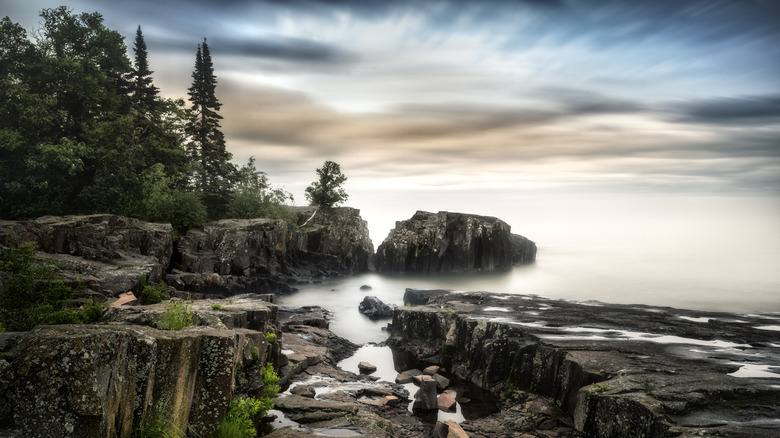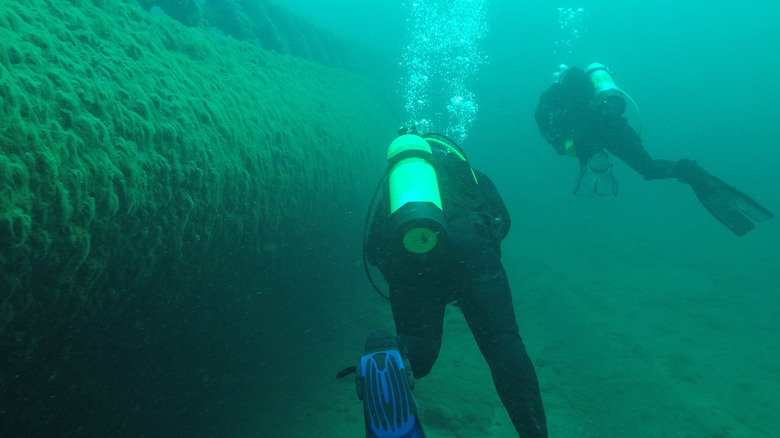This Stunning Great Lake Has The Cleanest Water That's Perfect For Swimming & Recreation
When it comes to outdoor splendor, North America boasts an abundance of gems. From the majesty of the Rocky Mountains to the vivid, otherworldly landscape of the American Southwest — as seen in Arizona's awe-inspiring Petrified Forest National Park — this massive continent seemingly has it all. There's something for every nature lover in North America, and perhaps nowhere captures its grandeur more than the Great Lakes.
Made up of the interconnected Lake Superior, Lake Michigan, Lake Huron, Lake Ontario, and Lake Erie — the Great Lakes straddle the border between Canada and the United States. These natural reservoirs contain 84% of the fresh water in North America and 21% of the world's supply, driving home just how massive they are. The waterways of the Great Lakes have also acted as vital trade routes for centuries, eventually giving rise to great cities such as Chicago, Milwaukee, Toronto, Cleveland, and Detroit, not to mention these scenic towns that are also worth a visit.
While the Great Lakes have been instrumental in the commerce that has helped build the two nations they call home, they're also exceptional natural attractions. Each has its own unique charms, though over the years pollution has been an issue in some of the lakes. That said, one in particular — the mighty Lake Superior — has largely avoided this problem. Today, it boasts the most pristine water not of just the five Great Lakes — but also the 100 largest lakes in the U.S. — making it the ideal destination for outdoor pursuits.
Dive into the crystal clear waters of Lake Superior
Occupying a surface area of 31,000 square miles and reaching depths of 1,332 feet, Lake Superior is the largest of the Great Lakes. Three U.S. states call its shoreline home — Michigan, Wisconsin, and Minnesota — along with the Canadian province of Ontario. Unlike the other lakes, there are no big cities on Lake Superior. In fact, much of its shoreline is made up of thick stands of forest, beaches, bluffs, hidden coves, and sand dunes. This lack of human development surely contributes to the fact that, according to a 2025 study released by Lake.com, Lake Superior was found to be the cleanest large lake in the United States, registering almost zero pollution.
The cold, clear waters of Lake Superior are perfect for a range of activities, including swimming, kayaking, canoeing, stand up paddle boarding, windsurfing, and scuba diving. The lake is especially good for wreck diving, as over the years, Superior has claimed hundreds of vessels — some of which can be explored in Isle Royal National Park. Just know that the water in Lake Superior is very cold, rarely topping 55 degrees Fahrenheit, which means divers must take extra precautions. Also, some of the wrecks sit at depths of greater than 60 feet, making experience, certification, and special equipment — including dry suits — a must.
Given its size and clean water, it should also come as no surprise that Lake Superior offers loads of opportunities for anglers hoping to hook into a monster of the deep. The lake is home to bass walleye, northern pike, trout (including massive lake trout), as well as four species of salmon. Fishing can be done from the shore or a on a boat, though for best results, consider chartering a guide.
Explore the parks of Lake Superior
Lake Superior remains the wildest of all the Great Lakes, and one reason for this is that its shoreline (and one of its islands) is home to a number of parks, both on the U.S. and Canadian side of the border. Heading into these protected areas is to experience the lake in its most unspoiled form, and they all make great launchpads for getting out onto the water.
Situated in Michigan's rugged and remote Upper Peninsula, Pictured Rocks National Lakeshore is worth visiting for the colorful cliffs best seen from the surface of Lake Superior. It's also home to inland lakes, thick forests, as well as an uncrowded, little-known beach with a rustic campground. Farther along the Michigan coast is Porcupine Mountains Wilderness State Park, which offers plenty of opportunities for camping in and hiking throughout its 60,000 acres of old-growth forests. Composed of 450 islands, Isle Royal National Park is only accessible by boat or seaplane, and can be explored offshore or on land via 150 miles of hiking trails. Minnesota's Grand Portage State Park features not just scenic shoreline, but also the state's highest waterfall.
On the Canadian side, check out Lake Superior Provincial Park, which boasts a variety of scenery along with campgrounds, great fishing, and some of the best fall foliage on the Great Lakes' shore. However, the grand jewel may be Pukaskwa National Park in central Ontario, a massive expansive covering 464,000 acres of pure wilderness. Whether you choose to camp, hike, or paddle, you'll likely beat the crowds found at more popular spots in the province. To get a full sense of what Lake Superior is all about, start the car and take in breathtaking lake views on this Midwest road trip route.


